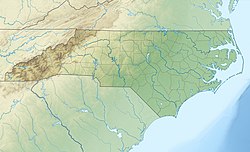New Bern, North Carolina | |
|---|---|
 Main façade of the New Bern City Hall | |
|
| |
| Nickname: The Birthplace of Pepsi[1] | |
 Location in Craven County and the state of North Carolina | |
Location in the United States | |
| Coordinates: 35°05′45″N 77°04′20″W / 35.09583°N 77.07222°W | |
| Country | |
| State | |
| County | Craven |
| Founded | October 1710 |
| Chartered | November 23, 1723 |
| Founded by | Baron of Bernberg |
| Named for | Bern, Switzerland |
| Area | |
• Total | 29.95 sq mi (77.56 km2) |
| • Land | 28.46 sq mi (73.70 km2) |
| • Water | 1.49 sq mi (3.86 km2) |
| Elevation | 13 ft (4 m) |
| Population (2020) | |
• Total | 31,291 |
| • Density | 1,099.59/sq mi (424.56/km2) |
| Time zone | UTC-5 (Eastern (EST)) |
| • Summer (DST) | UTC-4 (EDT) |
| ZIP codes | 28560, 28562 |
| Area code | 252 |
| FIPS code | 37-46340[4] |
| GNIS feature ID | 2404358[3] |
| Website | newbernnc |
New Bern (formerly Newbern[6]) is a city in and the county seat of Craven County, North Carolina, United States. At the 2020 census, it had a population of 31,291.[7] It is located at the confluence of the Neuse and the Trent rivers, near the headwaters of Pamlico Sound on the North Carolina coast. It lies 112 miles (180 km) east of Raleigh, 89 miles (143 km) north of Wilmington, and 162 miles (261 km) south of Norfolk.
New Bern was founded in October 1710 by the Palatines and Swiss under the leadership of Christoph von Graffenried. The new colonists named their settlement after Bern, the Swiss region from which many of the colonists and their patron had emigrated.[8] New Bern is the second-oldest European-settled colonial town in North Carolina, after Bath.[9] It served as the capital of North Carolina from 1770 to 1792. After the American Revolution (1775–1783), New Bern became wealthy and quickly developed a rich cultural life. At one time New Bern was called "the Athens of the South,"[9] renowned for its Masonic Temple and Athens Theater. These are both still very active today.
New Bern has four historic districts listed on the National Register of Historic Places; their numerous contributing buildings include residences, stores and churches dating back to the early eighteenth century. Within walking distance of the waterfront are more than 164 homes and buildings listed on the National Register. Also nearby are several bed and breakfasts, hotels, restaurants, banks, antiques stores and specialty shops. The historic districts contain many of the city's 2,000 crape myrtles—its official flower—and developed gardens. New Bern has two "Local Historic Districts", a municipal zoning overlay that affords legal protection to the exteriors of New Bern's historic structures.
- ^ Gary (August 3, 2021). "Visit The Birthplace of Pepsi - NC!". Island Life NC. Retrieved April 1, 2023.
- ^ "ArcGIS REST Services Directory". United States Census Bureau. Retrieved September 20, 2022.
- ^ a b U.S. Geological Survey Geographic Names Information System: New Bern, North Carolina
- ^ "U.S. Census website". United States Census Bureau. Retrieved January 31, 2008.
- ^ "Board of Aldermen". New Bern, Official Website.
- ^ Swan, Samuel, ed. (1752). A Collection of All the Public Acts of Assembly, of The Province of North-Carolina: Now in Force and Use. Newbern: James Davis. p. 37. OCLC 655409138. OL 24141080M.
- ^ "Geographic Identifiers: 2010 Demographic Profile Data (G001): New Bern city, North Carolina". U.S. Census Bureau, American Factfinder. Archived from the original on February 12, 2020. Retrieved January 2, 2015.
- ^ Colonial Records of North Carolina. n.d. pp. 985–986. LCCN 01006807. OCLC 2864657 – via Internet Archive.
- ^ a b "New Bern History". New Bern Visitors. Retrieved April 9, 2019.




